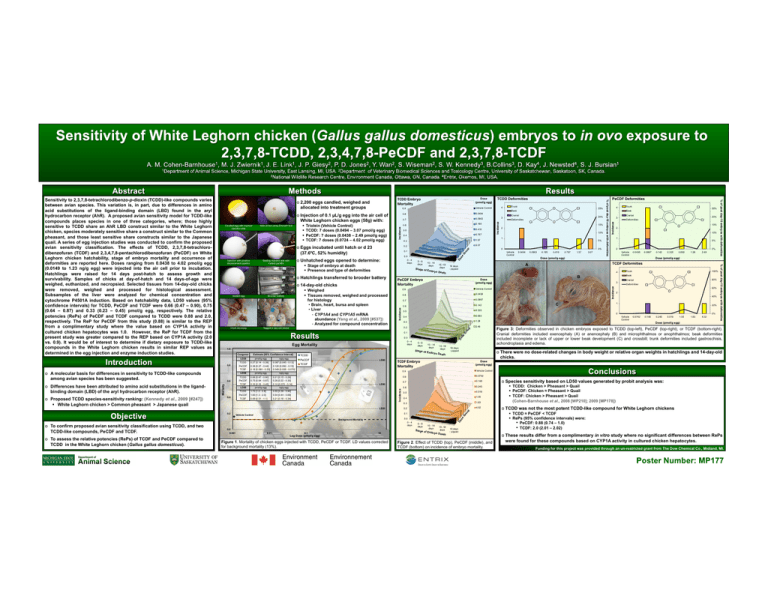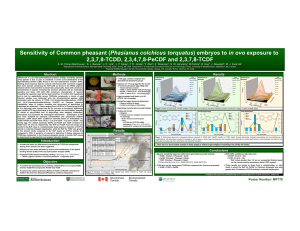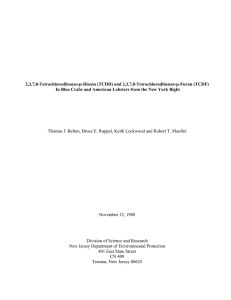2,200 eggs candled, weighed and p allocated into treatment groups
advertisement

0.195 0.5 0.416 0.4 0.767 0.3 1.57 0.2 3.07 ou 10 - 14 days Embryo 15 -18 days Death 0.6 0.142 0.5 0.335 0.4 0.693 0.3 1.38 0.2 2.49 TCDD 0.27 [0.14 - 0.39] 0.087 [0.045 - 0.13] 0.8 PeCDF TCDF 0.36 [0.27 - 0.44] 0.16 [0.090 - 0.23] 0.120 [0.092 - 0.15] 0.049 [0.028 - 0.070] TCDD 0.66 [0.47 - 0.90] 0.21 [0.15 - 0.29] 0.6 PeCDF TCDF LD80 0.75 [0.64 - 0.87] 0.33 [0.23 - 0.45] pmol/g egg 0.26 [0.22 - 0.30] 0.10 [0.070 - 0.14] ng/g egg TCDD 1.70 [1.2 - 2.8] 0.55 [0.39 - 0.90] PeCDF 1.60 [1.3 - 2.0] 0.54 [0.44 - 0.68] TCDF 0.69 [0.51 - 1.1] 0.21 [0.16 - 0.34] Mortality Gr se 5-9 days TCDD PeCDF LD80 TCDF ng/g egg LD50 15 -18 days Death 19 days - pipped Dose (pmol/g egg) 0.9 Vehicle Control 0.8 0.0742 0.7 0.148 0.6 0.245 0.5 0.516 0.4 1.05 0.3 1.83 0.2 4.02 o To assess the relative potencies (RePs) of TCDF and PeCDF compared to TCDD in the White Leghorn chicken (Gallus gallus domesticus). 0-4 days 0.0 0.001 0.01 0.1 Log Dose (pmol/g egg) 1 10 Figure 1. Mortality of chicken eggs injected with TCDD, PeCDF or TCDF. LD values corrected for background mortality (13%). se 0.0 Background Mortality o To confirm proposed avian sensitivity classification using TCDD, and two TCDD-like compounds, PeCDF and TCDF. Gr 0.1 Vehicle Control 5-9 days Stage of Do 0.2 ou p LD20 10 - 14 days Embryo TCDF Embryo Mortality Incidence pmol/g egg LD50 0.4 Do 0-4 days Stage of ng/g egg 0.0963 0.195 0.416 0.767 1.57 10 - 14 days Embryo 15 -18 days Death 3.07 Trunk 25% Beak 3 Cranial 20% Deformities 15% 2 10% 1 5% 0 0% Vehicle Control 0.0438 0.0867 19 days - pipped Figure 2. Effect of TCDD (top), PeCDF (middle), and TCDF (bottom) on incidence of embryo mortality. 0.142 0.335 0.693 1.38 2.49 Dose (pmol/g egg) TCDF Deformities Trunk 100% Beak B 3 Incidence 0.0867 p 0.0438 0.7 0.0 pmol/g egg 0% 0.0494 Vehicle Control 1.0 Estimate [95% Confidence Interval] 5% 4 4 0.1 Congener 10% 1 Dose (pmol/g egg) 0.8 Egg Mortality 15% 2 A 0.9 Tagged 2-day-old chicks 20% Deformities Vehicle Control 19 days - pipped PeCDF Embryo Incidence Brooder battery Cranial PeCDF Deformities Dose (pmol/g egg) Mortality Weighed Tissues removed, weighed and processed for histology • Brain, heart, bursa and spleen • Liver - CYP1A4 and CYP1A5 mRNA abundance (Yang et al., 2009 [#537]) - Analyzed for compound concentration 3 0 Gr Stage of 25% Beak C 80% Cranial Deformities 60% 2 40% 1 20% 0 0% Vehicle Control 0.0742 0.148 0.245 0.516 1.05 1.83 4.02 % of post day-10 embryos with deformities Stage of embryo at death Presence and type of deformities 5-9 days Trunk Do 0-4 days se 0.0 4 Incidence 0.6 TCDD Deformities Incidence 0.0963 0.1 o 14-day-old chicks Chick necropsy 0.0494 0.7 o Unhatched eggs opened to determine: o Hatchlings transferred to brooder battery Sealed egg 0.8 p o Eggs incubated until hatch or d 23 (37.6ºC, 52% humidity) Sealing injection site with melted paraffin Injection with positive displacement pipettor o A molecular basis for differences in sensitivity to TCDD-like compounds among avian species has been suggested. o Proposed TCDD species-sensitivity ranking: (Kennedy et al., 2009 [#247]) White Leghorn chicken > Common pheasant > Japanese quail Triolein (Vehicle Control) TCDD: 7 doses (0.0494 – 3.07 pmol/g egg) PeCDF: 7 doses (0.0438 – 2.49 pmol/g egg) TCDF: 7 doses (0.0724 – 4.02 pmol/g egg) Vehicle Control ou Hole drilled using Dremel® tool Incidence Candled egg with marked injection side Dose (pmol/g egg) 0.9 % of post day-10 embryos with deformities o Injection of 0.1 µL/g egg into the air cell of White Leghorn chicken eggs (58g) with: LD20 o Differences have been attributed to amino acid substitutions in the ligandbinding domain (LBD) of the aryl hydrocarbon receptor (AhR). TCDD Embryo Mortality o 2,200 eggs candled, weighed and allocated into treatment groups % of post day-10 embryos with deformities Sensitivity to 2,3,7,8-tetrachlorodibenzo-p-dioxin (TCDD)-like compounds varies between avian species. This variation is, in part, due to differences in amino acid substitutions of the ligand-binding domain (LBD) found in the aryl hydrocarbon receptor (AhR). A proposed avian sensitivity model for TCDD-like compounds places species in one of three categories, where; those highly sensitive to TCDD share an AhR LBD construct similar to the White Leghorn chicken, species moderately sensitive share a construct similar to the Common pheasant, and those least sensitive share constructs similar to the Japanese quail. A series of egg injection studies was conducted to confirm the proposed avian sensitivity classification. The effects of TCDD, 2,3,7,8-tetrachlorodibenzofuran (TCDF) and 2,3,4,7,8-pentachlorodibenzofuran (PeCDF) on White Leghorn chicken hatchability, stage of embryo mortality and occurrence of deformities are reported here. Doses ranging from 0.0438 to 4.02 pmol/g egg (0.0149 to 1.23 ng/g egg) were injected into the air cell prior to incubation. Hatchlings were raised for 14 days post-hatch to assess growth and survivability. Samples of chicks at day-of-hatch and 14 days-of-age were weighed, euthanized, and necropsied. Selected tissues from 14-day-old chicks were removed, weighed and processed for histological assessment. Subsamples of the liver were analyzed for chemical concentration and cytochrome P4501A induction. Based on hatchability data, LD50 values (95% confidence intervals) for TCDD, PeCDF and TCDF were 0.66 (0.47 – 0.90), 0.75 (0.64 – 0.87) and 0.33 (0.23 – 0.45) pmol/g egg, respectively. The relative potencies (RePs) of PeCDF and TCDF compared to TCDD were 0.88 and 2.0, respectively. The ReP for PeCDF from this study (0.88) is similar to the REP from a complimentary study where the value based on CYP1A activity in cultured chicken hepatocytes was 1.0. However, the ReP for TCDF from the present study was greater compared to the REP based on CYP1A activity (2.0 vs. 0.9). It would be of interest to determine if dietary exposure to TCDD-like compounds in the White Leghorn chicken results in similar REP values as determined in the egg injection and enzyme induction studies. Dose (pmol/g egg) Figure 3: Deformities observed in chicken embryos exposed to TCDD (top-left), PeCDF (top-right), or TCDF (bottom-right). Cranial deformities included exencephaly (A) or anencephaly (B) and microphthalmos or anophthalmos; beak deformities included incomplete or lack of upper or lower beak development (C) and crossbill; trunk deformities included gastroschisis, achondroplasia and edema. o There were no dose-related changes in body weight or relative organ weights in hatchlings and 14-day-old chicks. o Species sensitivity based on LD50 values generated by probit analysis was: TCDD: Chicken > Pheasant > Quail PeCDF: Chicken ≈ Pheasant > Quail TCDF: Chicken > Pheasant > Quail (Cohen-Barnhouse et al., 2008 [WP210]; 2009 [MP178]) o TCDD was not the most potent TCDD-like compound for White Leghorn chickens TCDD ≈ PeCDF < TCDF RePs (95% confidence intervals) were: • PeCDF: 0.88 (0.74 – 1.0) • TCDF: 2.0 (2.01 – 2.02) o These results differ from a complimentary in vitro study where no significant differences between RePs were found for these compounds based on CYP1A activity in cultured chicken hepatocytes. Funding for this project was provided through an un-restricted grant from The Dow Chemical Co., Midland, MI.







